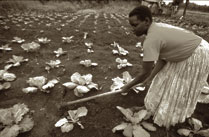
Learning about sector-wide approaches
There are few SWAps in agriculture and rural development and their impact is unclear. So why should IFAD be involved?

Sector-wide approaches (SWAps) are nationally owned programmes to achieve growth and poverty reduction through a focus on a certain sector. IFAD's policy on sector-wide approaches for agriculture and rural development was approved by the Executive Board in April 2005. Ed Heinemann, regional economist for the Eastern and Southern Africa Division, clarifies some points.
1. What are the benefits of SWAps?
SWAps are an effort to improve the effectiveness of development aid. Instead of supporting individual projects, donors and lenders collectively contribute to a single programme for the sector defined by the partner government as part of its broader poverty reduction strategy. The aim is to promote country ownership, contribute to harmonization, reduce transaction costs and streamline monitoring and accounting mechanisms. The first SWAps were developed for health and education; SWAps in agriculture and rural development are still quite limited.
2. If the SWAp phenomenon is so limited in the agricultural and rural sector, why should IFAD be involved?
IFAD is a relatively large financier in the agricultural sector of many countries – in particular those in which SWAps are being implemented. We can help to ensure that SWAps work for rural poor people. IFAD can also propose practical ways for implementing them at field level – an area in which experience is generally lacking.
3. What is the most appropriate financial arrangement for IFAD to get involved in SWAps?
What is not appropriate for an agency such as IFAD, with its very specific rural focus and mandate, is general or even sector-level budget support. IFAD must channel its resources in support of a specific and defined programme for rural poverty reduction – that is, a SWAp. IFAD may contribute to a pooled or basket funding arrangement for a SWAp, or provide earmarked funding for certain components of a SWAp, or finance stand-alone projects within a SWAp.
4. In a basket funding arrangement, how would IFAD be sure of how its resources were being used?
Unlike in a traditional project, in a basket funding arrangement it is not possible for contributing financiers to track exactly how their individual resources are being used. So IFAD would need to look at the SWAp as a whole. Together with the government and its other development partners, we would review the programme annual workplans and budgets, the financial and implementation progress reports, and the audited accounts. In this way we would agree up front what activities would be carried out, and for what purpose and at what cost, and we would subsequently confirm that activities actually carried out and the expenditures realized were in conformity with what had been agreed.
5. Would that not require having a country presence, something that is difficult under IFAD's current operating model?
Engaging effectively in programme development and policy dialogue without a country presence may prove challenging for IFAD. Up until now we have mobilized local representatives under the Field Presence Pilot Initiative, approved by the Executive Board in 2003, or through ad hoc arrangements. We will need to see whether this is sufficient to allow IFAD to contribute effectively to SWAps or whether additional measures are required.
6. If IFAD chooses a basket funding arrangement, the SWAp policy dictates that the World Bank must endorse it. Why is this?
IFAD does not have a particular strength in analysing fiduciary arrangements or organizing procurement – areas where the World Bank has expertise. So until IFAD builds its capacity for loan administration, our policy will be to enter into basket funding arrangements only where the World Bank is either participating or giving the government budget support.
7. What is needed to ensure that agricultural SWAps are effective?
The elements that make agricultural SWAps effective are the same things IFAD believes are essential to reduce rural poverty. For example, policies and investments must be based on an understanding of the livelihoods of rural poor people. The best way to ensure that SWAps are effective is to involve poor people in their design and implementation.
8. What do we know about the impact of SWAps for agriculture and rural development?
Not enough, especially since the number of these SWAps is limited and they are quite new. This is a major shortcoming. IFAD will need to make sure that impact monitoring systems are part of any SWAps we participate in. We must also promote a management culture in which impact is considered paramount, and we must demand monitoring and evaluation data.
9. Can IFAD pursue SWAps while maintaining a project-based approach? How do these two fit together?
Yes, absolutely. For one, SWAps do not address all economic issues facing rural poor people. Rural finance, for example, is typically outside the scope of SWAps. So even where IFAD is supporting a SWAp, as it is currently doing in Uganda and in the United Republic of Tanzania, it is also financing projects in other areas essential for rural poverty reduction. Secondly, SWAps need not be monolithic. They can provide a general framework for rural development, which is articulated through projects and programmes that meet clearly defined criteria.
10. What is the link between PRSPs and SWAps?
Poverty reduction strategy papers (PRSPs) are national frameworks to articulate how a government will achieve the Millennium Development Goals. SWAps are one possible way that those poverty reduction efforts can be operationalized at the sectoral level.
Useful link:
- IFAD Policy on Sector-Wide Approaches for Agriculture and Rural Development
Arabic | English | French | Spanish